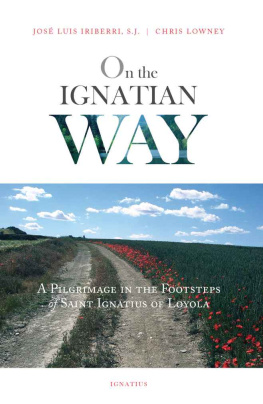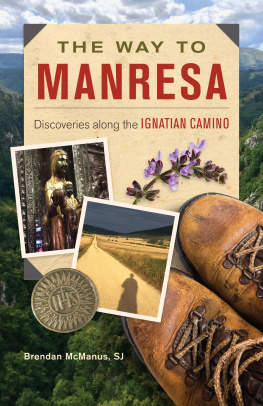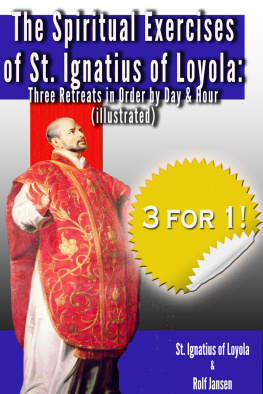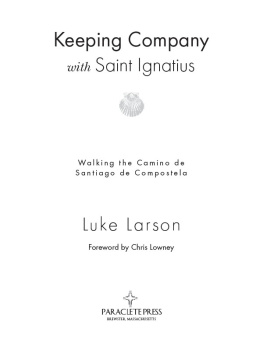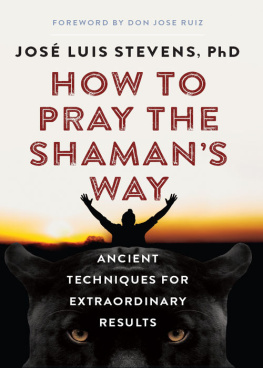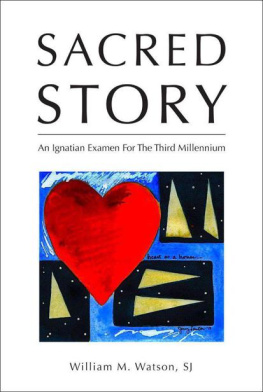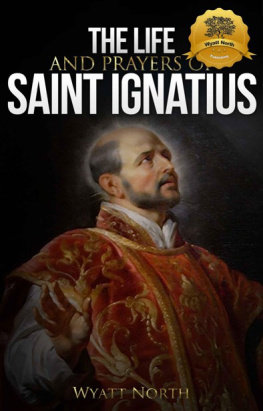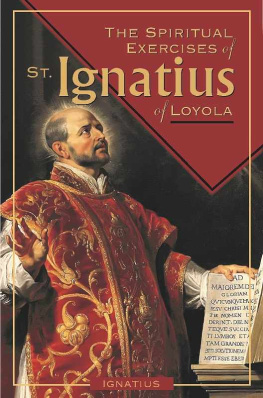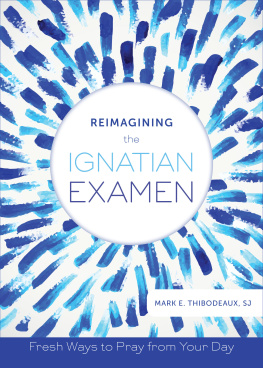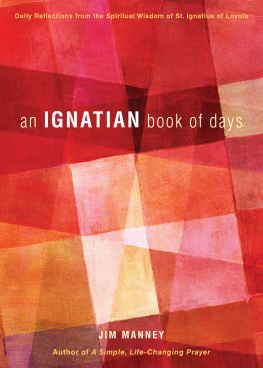José Luis Iberri - On the Ignatian Way : A Pilgrimage in the Footsteps of Saint Ignatius of Loyola
Here you can read online José Luis Iberri - On the Ignatian Way : A Pilgrimage in the Footsteps of Saint Ignatius of Loyola full text of the book (entire story) in english for free. Download pdf and epub, get meaning, cover and reviews about this ebook. year: 2018, genre: Religion. Description of the work, (preface) as well as reviews are available. Best literature library LitArk.com created for fans of good reading and offers a wide selection of genres:
Romance novel
Science fiction
Adventure
Detective
Science
History
Home and family
Prose
Art
Politics
Computer
Non-fiction
Religion
Business
Children
Humor
Choose a favorite category and find really read worthwhile books. Enjoy immersion in the world of imagination, feel the emotions of the characters or learn something new for yourself, make an fascinating discovery.
- Book:On the Ignatian Way : A Pilgrimage in the Footsteps of Saint Ignatius of Loyola
- Author:
- Genre:
- Year:2018
- Rating:4 / 5
- Favourites:Add to favourites
- Your mark:
- 80
- 1
- 2
- 3
- 4
- 5
On the Ignatian Way : A Pilgrimage in the Footsteps of Saint Ignatius of Loyola: summary, description and annotation
We offer to read an annotation, description, summary or preface (depends on what the author of the book "On the Ignatian Way : A Pilgrimage in the Footsteps of Saint Ignatius of Loyola" wrote himself). If you haven't found the necessary information about the book — write in the comments, we will try to find it.
José Luis Iberri: author's other books
Who wrote On the Ignatian Way : A Pilgrimage in the Footsteps of Saint Ignatius of Loyola? Find out the surname, the name of the author of the book and a list of all author's works by series.
On the Ignatian Way : A Pilgrimage in the Footsteps of Saint Ignatius of Loyola — read online for free the complete book (whole text) full work
Below is the text of the book, divided by pages. System saving the place of the last page read, allows you to conveniently read the book "On the Ignatian Way : A Pilgrimage in the Footsteps of Saint Ignatius of Loyola" online for free, without having to search again every time where you left off. Put a bookmark, and you can go to the page where you finished reading at any time.
Font size:
Interval:
Bookmark:
ON THE IGNATIAN WAY
JOS LUIS IRIBERRI, S.J.
CHRIS LOWNEY
of Saint Ignatius of Loyola
TRANSLATED BY
CHRISTOPHER J. LOCASCIO
IGNATIUS PRESS SAN FRANCISCO
Original Spanish edition:
El Camino Ignaciano
Un camino de sanacin hacia la libertad
2015 by Ediciones Mensajero, Bilbao
Unless otherwise indicated, Scripture quotations are from the Revised Standard Version of the BibleSecond Catholic Edition (Ignatius Edition) copyright 2006 National Council of the Churches of Christ in the United States of America. All rights reserved worldwide.
Cover design by Enrique J. Aguilar
2018 Copyright by Ignatius Press, San Francisco
All rights reserved
ISBN 978-1-62164-146-9 (PB)
ISBN 978-1-64229-031-8 (EB)
Library of Congress Control Number 2017932734
Printed in the United States of America
by Jos Luis Iriberri, S.J .
by Chris Lowney
II. THE IGNATIAN WAY:
A HEALING PATH TO FREEDOM
by Jos Luis Iriberri, S.J .
by Sarah Davies
by Andrew Walsh and Gillian McIlwain
by R. B. Riyo Mursanto, S.J .
by Michael Smith, S.J .
by John N. G .
by Gillian McIlwain
by Alain Lemaire
by Natalie Lacroix
by Terry Howard, S.J .
III. PRAYING THE IGNATIAN WAY:
A DAILY GUIDE
by Chris Lowney
We present this guide, written collaboratively by various European, Australian, and North American authors, in order to offer pilgrims an instrument that might help them to advance on their interior way. All the authors are themselves experienced pilgrims, not only on the Ignatian Way, but also on other pilgrimages. It is on the basis of their own experience and knowledge of Ignatian spirituality that they propose this interior guide. The first and second parts are descriptive of the pilgrims own experience, as testimony of what can happen. The third part is devoted to an adaptation of the Spiritual Exercises specific to the Ignatian pilgrimage. Jos Luis Iriberri, S.J., was the final editor of the work, but he has respected as much as possible the original styles of each author.
A New Pilgrimage for a New Age
by Jos Luis Iriberri, S.J .
We begin here a journey following the trails of the Ignatian Way from Loyola to Manresa and Barcelona. Every pilgrimage route is born from the initiative of someone, in this case, the Society of Jesus; an initiative confirmed in the commission the provincial superiors have given to me and my two companions in adventure, Jaime Badiola, S.J., and Chris Lowney. At the end of 2010, we began to design this new pilgrimage for the twenty-first century following the footsteps of Saint Ignatius, our holy founder. Clearly, the goal we set before ourselves was apostolic, linked from its beginning to the experience of the Spiritual Exercises . We understood that a way of pilgrimage always had to be an instrument at the service of the human person, of his growth as a person for the sake of some ideals, constantly responding to the inner search for meaning and happiness. It was in this way that the Ignatian Way was born, accompanied and assisted by more than thirty volunteers from five different countries, all of them connected to the spirit and legacy of Ignatius.
This is the formal beginning, but in reality a true Way of Pilgrimage is created through the hundreds and thousands of experiences that pilgrims have had throughout the years. The pilgrimage is created by the pilgrims and by the interaction that is established between their experience and the inhabitants of each town and city they encounter along their path. As has been studied and well said, with the passage of pilgrims, territories are united, habits are changed, and new cultures are even created, thanks to the dialogues, the laughter, and the exchange of knowledge that is produced in the paths trodden by the sandals or boots of the pilgrims. It would be unfair not to recognize the transfer of knowledge in health, cuisine, and architecture, among many others, that came to medieval Europe from the Iberian Peninsula thanks, for example, to the Way of Saint James (Camino de Santiago): the pilgrims, some rich and others poor, some nobles and others plebian, explained and shared not only their spiritual experiences but also the novelties that were produced in such disparate cultures as those through which they traveled.
This humble text attempts to initiate that tradition which would construct the Ignatian Way based on the pilgrims, its true champions. A particular experience says very little; therefore, rather than relate my own experience, I unite with those of other pilgrims to construct our account together. It is none other than this which is the spirit of pilgrimage: to create profound and transforming communion with God. It is our sincere wish that the nearly 435 miles of the Ignatian Way may serve also today to unite people from many cultures and with different interests.
My own experience as a pilgrim now amounts to some thousands of miles, mostly alone and on foot, as the master Ignatius of Loyola often proposed. But if, upon speaking of pilgrimages, the reader is left with the impression that the important thing is the distance or the miles covered, he would be making a mistake in his approach that I would like to help to clear up: to go on pilgrimage is not to walk the maximum number of miles in the minimum amount of time. This would be a physical competition or, if you like, a spiritual voyage in which the physical component is the most important, which would put the body before the spirit. Those who know the ways of pilgrimage know very well that, the more space the physical body occupies, the less personal time and space is left for the spiritual dimension. The external physical way is no more than a precious instrument to open the door to the interior way, which leads the pilgrim to discover himself as a profound being and, from our Ignatian viewpoint, as a being profoundly loved by the One who gives origin to the universe and who gives life to each of us individually. And to come to this, to feel deeply loved, the person does not need to walk thousands of miles, not even a few hundred: the God who surprises us and who surprised Ignatius in his room at Loyola also awaits us at whatever point of the journey we follow. Paraphrasing the master, we know that it is not many miles that fill and satisfy the soul, but savoring inwardly that which we experience in each step.
One of the pilgrims who collaborated in the writing of these pages that we present, Sarah Davies, after her thirty days of pilgrimage, shares with us this anecdote:
On the way home, on the first leg of the plane trip I sat beside a man who had been touring Europe, ending up in Spain. Among other things, he asked me about what I had been doing; and when I told him about my Ignatian pilgrimage, his first question was about how many miles I had walked. Only 250? Well... that is not bad, but he had a friend who had walked 500 miles on the Way of Saint James. His reaction made me think. If people think that a pilgrimage is a competition of miles, it would be good if in these pages we show a different side of what a pilgrimage is.It seems to me very pertinent to begin with this commentary, since it touches on the essence of what we want to contribute with our reflection: a pilgrimage like ours is measured, not by the distance or the speed, but by the depth at which we arrive, entering into contact with our inner selves and with that God who lives within us. And this encounter is achieved by walking, certainly, and also through the human relationships, the meditation, the contemplation of the surroundings, the effort, the conversations, the lessons learned about ones own life, and the new meanings that appear in it.
Next pageFont size:
Interval:
Bookmark:
Similar books «On the Ignatian Way : A Pilgrimage in the Footsteps of Saint Ignatius of Loyola»
Look at similar books to On the Ignatian Way : A Pilgrimage in the Footsteps of Saint Ignatius of Loyola. We have selected literature similar in name and meaning in the hope of providing readers with more options to find new, interesting, not yet read works.
Discussion, reviews of the book On the Ignatian Way : A Pilgrimage in the Footsteps of Saint Ignatius of Loyola and just readers' own opinions. Leave your comments, write what you think about the work, its meaning or the main characters. Specify what exactly you liked and what you didn't like, and why you think so.

